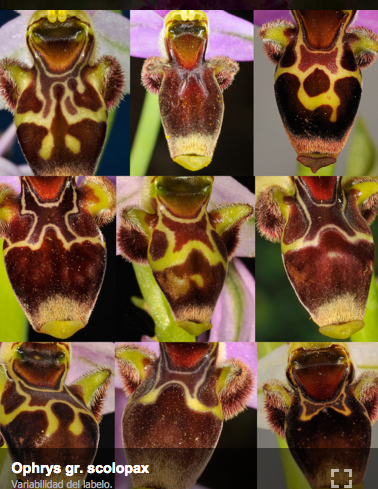To discover not one, but two!!!, wild orchids in my own garden is absolutely mind-blowing. The first — which I later identified with the aid of Orquídeas Ibéricas as a species of bee orchid, Ophrys scolopax — I spied on the very next day after we moved in. Having gone away for a fortnight, I thought the lone orchid would be gone by the time we returned. But no — instead there were more that had come up during my absence. Such joy :-).
They have an interesting sex life, these bee orchids. They’re quite naughty — apparently imitating the female of certain species of bees, including their scent, to lure unsuspecting males. The thoroughly enthralled male insect then comes, makes the appropriate overtures, et voila!, the orchid is fertilized. Looking at the range in variation of markings on all the species of bee orchids, and there are dozens, each one a unique insect, I cannot help wonder — which came first: the insect or the orchid? Parallel evolution in bees and orchids is truly a great wonder.

Range of markings on O. scolopax. Source: Orquideas Ibericas.
As the weather warmed up, those first Ophrys orchids dried up, hopefully setting seed before doing so. It is my understanding that the seeds only germinate in the presence of specific fungi, so the plan of taking out the hedge of toxic oleander along that side of the garden, and replacing it with fruiting feijoa or pitango (Surinam cherry), is off. I would rather leave that corner for wild orchids. The feijoa and pitango will have to go elsewhere.
I thought that was it, as far as orchids in the garden, but surprisingly, in an unexpected spot, totally bereft of trees and shade, I found another one. This time it was a pyramid orchid, Anacamptis pyramidalis, listed as widely distributed throughout Europe, from Ireland to southern Scandinavia. Thanks to Orquídeas Ibéricas once again. It certainly looked like an orchid that would prefer a moister environment, but wonder of wonders! here they are, one of them with three flowering spikes. It is apparently found on limestone territory (my garden’s numerous outcroppings definitely fits the bill) throughout the Western Mediterranean and most of Spain and Portugal (though less common in northern Spain).
Feeling truly blessed to have these ground orchids gracing the garden!







This is just what I wanted to know Jeanne. Thank you x
LikeLike
You’re very welcome and thank you for dropping by, Trixie. So pleased that you found it useful!
LikeLike